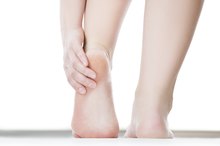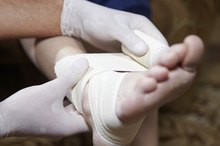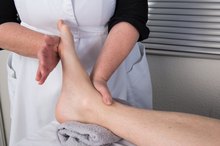Flat Feet & Dancing
Flat foot occurs when the arch of your foot flattens, allowing your entire foot to touch the floor. This condition is common and usually painless, but it can impact your ability to participate in athletic activities such as dancing. There is no cure for flat feet, but there are exercises you can do to help your feet stay strong and pain-free when you dance.
If you are experiencing serious medical symptoms, seek emergency treatment immediately.
Causes of Flat Foot
Several different factors can cause flat feet. The arches on your feet form as tendons strengthen and tighten; if those tendons are damaged through injury or illness, the arch will fall and create flat foot. Other causes include heredity and abnormalities such as an extra bone in the foot. People who naturally have flat feet will have an easier time adapting to the demands of dance, while those who have injury-induced flat feet will require some foot exercises to adjust to the condition.
- Several different factors can cause flat feet.
- The arches on your feet form as tendons strengthen and tighten; if those tendons are damaged through injury or illness, the arch will fall and create flat foot.
Exercises
How to Stretch the Foot Arch
Learn More
Regardless of why you have flat feet, there are exercises to help strengthen your tendons, which will help with the pointing, flexing, and balance involved in all styles of dance. Pick up items with your toes, then see how far you can throw them. Alternately, you can try to stack items using your toes. A clench-and-release exercise — clenching your foot as if you are trying to make a fist, then releasing it — will help strengthen the tendons on the bottom for your foot and help with dance movements that require pointed toes. You can also walk on tiptoes to help strengthen your feet.
- Regardless of why you have flat feet, there are exercises to help strengthen your tendons, which will help with the pointing, flexing, and balance involved in all styles of dance.
- A clench-and-release exercise — clenching your foot as if you are trying to make a fist, then releasing it — will help strengthen the tendons on the bottom for your foot and help with dance movements that require pointed toes.
Overpronation
Overpronation is one of the most common complications that result from flat feet 2. Overpronation puts immediate stress on your ankles and throws your knees and hips out of alignment 2. This can put more stress than normal on your body while you are dancing. As a result, if you are a flat-footed dancer, you need to be more aware of how you are stepping and how you are placing your weight with each step.
Pain
Exercises for Tendonitis of the Foot
Learn More
If you are new to dancing and have flat feet, or if you are developing flat feet due to age, you may experience some initial discomfort until the tendons in your feet become strong enough to support you throughout the dance. But if you experience regular, consistent pain while dancing, there may be a more serious underlying problem. Visit your doctor to determine what may be causing the excess pain and find a suitable treatment for it.
Related Articles
References
- American Academy of Orthopaedic Surgeons: Adult (Acquired) Flatfoot
- Sports Injury Clinic: Overpronation
- American Academy of Orthopaedic Surgeons. Flexible flatfoot in children. Updated October, 2018.
- Vulcano E, Deland JT, Ellis SJ. Approach and treatment of the adult acquired flatfoot deformity. Curr Rev Musculoskelet Med. 2013;6(4):294–303. doi:10.1007/s12178-013-9173-z
- Arain A, Harrington MC, Rosenbaum AJ. Adult acquired flatfoot (AAFD) [Updated 2019 Jun 9]. In: StatPearls. Treasure Island (FL): StatPearls Publishing; 2019 Jan.
- Tao X, Chen W, Tang K. Surgical procedures for treatment of adult acquired flatfoot deformity: a network meta-analysis. J Orthop Surg Res. 2019;14(1):62. Published 2019 Feb 21. doi:10.1186/s13018-019-1094-0
Resources
Writer Bio
Katie Strzeszewski has been writing professionally since 2003 and holds a Bachelor of Arts in professional writing and English secondary education from York College of Pennsylvania. Strzeszewski spent two years performing computer repair for Geek Squad, currently works for men's clothier Paul Fredrick and is also a competitive West Coast Swing and Hustle dancer.








